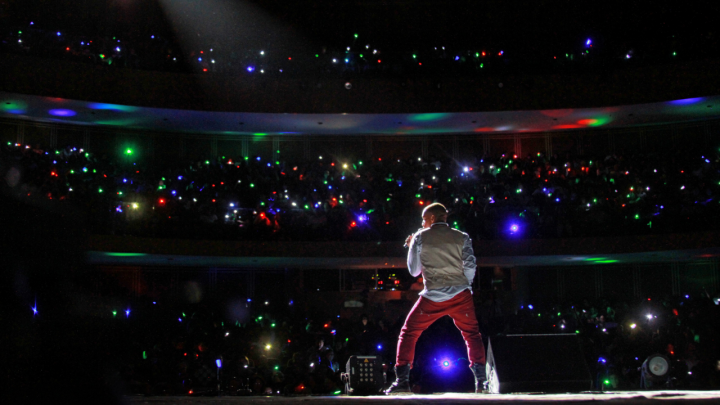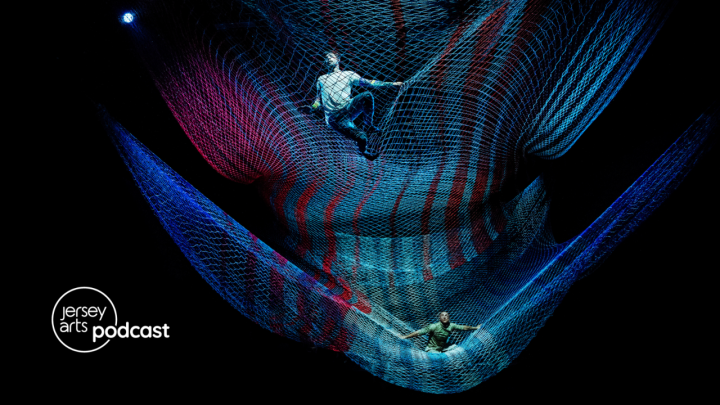Be transported to Cirque du Soleil's amazing world of TOTEM

Step into the giant yellow tent at the Camden Waterfront over the next few weeks, and you’ll be transported into the world of TOTEM, the latest touring show from exotic acrobatic troupe Cirque du Soleil. You’ll also get one of the flashiest science lessons around.
Totem explores the history of evolution, starting off with a swamp filled with frogs and fish. So no, cast member Greg Kennedy explains, it’s not your ordinary Cirque performance.
“We have a more earthy show,” says Kennedy, a world-champion juggler who plays The Scientist, the show’s quasi-narrator. “It’s not traditional Cirque, with the swirly costumes. You see real faces mixed in. It has a real kind of tribal feel to it. We’re looking at totems that inspire us from the past.”

The show is a homecoming for Kennedy, who grew up in Lake Hopatcong. After graduating from Drexel University with an engineering degree, he went to work as an engineer in New York City for three years, living in the Garfield and the Elmwood Park area.
But then, Kennedy took a risk. He left his job and went on the road as a professional juggler, a skill he developed since he was a young boy. The plan panned out: Kennedy has spent the past few decades performing, the last five years with Cirque. He now lives with his wife and three children across the Delaware River, in the Philadelphia suburbs.
Kennedy spoke with Jersey Arts’ Brent Johnson about how why he left a steady job to juggle, how Cirque discovered him, and how his unusual style works into TOTEM.
Jersey Arts: How does a young kid growing up in Sussex County get into juggling?
Greg Kennedy: It was an activity I picked up as a kid — a fun thing to do. Then, I kind of got good at it as a kid. I kind of went with it. Then, after engineering school, I started specializing in more and more forms of juggling — bouncing, rolling balls of different shapes, creating whole new forms of juggling. I built a following in the juggling community, which is a fairly small community worldwide. That’s how I was found by Cirque.

JA: And when did you leave your engineering job to juggle full-time?
GK: It was in the 1990s. I was juggling before. It was a hobby. I was even doing some shows — in Atlantic City casinos on the weekends for fun. I didn’t really need the money. At some point, I was competing a lot at juggling festivals. And in 1996, I won gold at the International Juggler Association Championship.
Six months after that, a buddy said, ‘Hey, I am going to Japan. They are going to take two other people. Want to come to Japan and work six months as a juggler? So I took a six-month leave of absence from job in engineering. That was February 1997. I kind of overstayed my leave of absences. (laughs)
JA: What kind of engineering?
GK: My degree is in civil engineering, with a specialty in geotechnical, rock slopes, and foundation systems.
JA: So you left a job that paid you well to try your hand at juggling?
GK: I would not recommend to anyone who has a choice between juggler and engineering to become a juggler. It is really hard to make it in entertainment. But once you get a following, the things trade places. There were quite a few hard years in the beginning when I was out on my own, but the freelance work built. Before I knew it, I was courted by a lot of people. Then five years ago, Cirque called.
JA: How did that happen?

GK: I had released some videos on YouTube. I didn’t come to Cirque via a traditional method. Usually, they check out festivals in Europe and pick up acts. I was already doing work around the world and had released some videos of my more modern work. They saw those, and said, ‘This is interesting and quirky — like nothing we’ve seen before.’
The creator of TOTEM liked what I did. He brought me up to a workshop in Montreal, and I showed them a bunch of stuff. They picked what they liked. They talked to me about becoming the Scientist character. I am not really a character actor, but it wasn’t too much of a stretch from my personality to play a scientist. It’s been a really fun ride the last five years.
JA: Did your parents have a problem when you said you were ditching your steady job to juggle?
GK: It was funny. When I brought it up that I was taking this leave of absence, I was expecting a pushback. But my dad said, ‘Hey, obviously you’re good at it, try it out and see if you like it.’ I was pretty surprised.
JA: What were the first things you learned how to juggle?
GK: When I started, it was traditional stuff as a kid — balls, clubs, and things. I got pretty good pretty quick. I could do five to seven balls. Later on, one of my signature pieces was rolling patterns in a clear plastic bowl. You could also see giant 45-degree mirrors overtop. That was really the precursor to my work in Cirque. I built on my work of the last 25 years.

JA: What is unique about the show?
GK: The show is loosely about evolution and animal totems people look back to. It starts off in a murky swamp with frogs and fish, and it moves through the end with a man trying to leap up and reach into space.
Throughout the show, I am the witness character who has tapped into this work and looks at it through a logical way. You see me in the background throughout the whole show.
And in the second act, I have my performance — in a laboratory. The way Cirque does it, there are musical instruments made of our laboratory equipment, and musicians are playing behind me. There is a video projection of green bubbles. It’s me and a monkey and my lab coat. Eventually, I move on and create glowing balls. I move inside a cone where I am rolling the balls around me. The balls change color with the radio frequency. It’s a beautiful image. Then, it moves on to the end of the experiment — me standing in the middle with planets and atoms moving around me.
I brought to the table the skills and the manipulation and I mixed it with Cirque, who not only have amazing budgets, but they don’t let practicality get in the way of art. They create and create and spend what they can.
JA: How much does your engineering background help with your juggling?
GK: I’m actually using what I learned with my engineering degree. A lot of the things I do are actually a little counterintuitive. Twenty percent of the audience says, ‘I should have seen that happen.’ Others say, ‘I don’t know why that happens.’ It all comes down to math. I actually feel I use my engineering degree more now than I did when I was an engineer.
JA: And your family travels with you as the show moves from city to city?
GK: I have my wife and kids on the road with me. It’s a great little deal I have.

JA: Do any of your children want to juggle for a living?
GK: My oldest wants to be a paleontologist. My next one wants to be a veterinarian. They are 10, 8, and 6. They take circus classes. We keep them active that way. But I am not going to push them into anything. I want them to enjoy their lives.
JA: Is there anything you’ve tried juggling that just didn’t work?
GK: Oh my goodness, yes. Before joining Cirque, I spent lots of time developing all forms of juggling. I found very quickly that you can’t get too frustrated or upset with loses. For everything you see on stage that I do, there are three or four things getting dusty in the basement.
I have a technique where I spend 100 hours on something to see if it’s going to pan out. Sometimes, it take several models to work. I run bun back to Home Depot and build another one. There have been hundreds of failures for failures for dozens of successes.
Cirque du Soleil presents TOTEM, a live performance, on the Camden Waterfront May 30-June 30.



